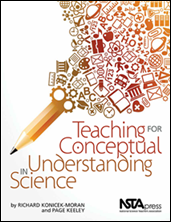Teaching for Conceptual Understanding in Science
By Carole Hayward
Posted on 2015-05-19
 Author Richard Konicek-Moran spent years studying and researching children’s alternative conceptions in science and author Page Keeley acquired her passion for improving conceptual understanding using formative assessment tools. They realized that their respective work had so much in common that they decided to put their thoughts and ideas gleaned from their experiences, research findings, and practices into a book that would focus on this important topic: Teaching for Conceptual Understanding in Science.
Author Richard Konicek-Moran spent years studying and researching children’s alternative conceptions in science and author Page Keeley acquired her passion for improving conceptual understanding using formative assessment tools. They realized that their respective work had so much in common that they decided to put their thoughts and ideas gleaned from their experiences, research findings, and practices into a book that would focus on this important topic: Teaching for Conceptual Understanding in Science.
What Does Conceptual Understanding Mean?
The authors explain it this way:
“Conceptual understanding is very much like making a cake from scratch without a recipe versus making a cake from a packaged mix. With the packaged mix, one does not have to think about the types and combination of ingredients or the steps involved. You make and bake the cake by following the directions on the box without really understanding what goes into making a cake. However, in making the cake from scratch, one must understand the types of ingredients that go into a cake and cause-and-effect relationships among them…. In other words, making the cake from scratch involves conceptual understanding rather than simply following a recipe.”
The book focuses on some key questions: How do we move our students from their present, limited knowledge of certain scientific concepts toward an understanding closer to what scientists now believe and that local, state, and national standards expect? What does current research tell us about building students’ deeper understanding of both science as a process and a set of practices and science as a knowledge base?
Children come to us with own conceptions about what makes the world work. They appear before us with minds full of ideas that they have developed to help them understand, in their own way, what makes the world tick. Their ideas were sufficient and allowed them to function, up to that point, but then in school they are introduced to ideas that may be different from those they held before.
These prior concepts are usually sound enough for a child to be comfortable with them, but we know that broader ideas are more useful and powerful. A student’s ideas are also ingrained and persistent. How in a child, just as in society in general, do these ideas change and become more useful?
Each chapter of the book tackles a specific question:
- Chapter 1: Teaching Science for Conceptual Understanding: An Overview
- Chapter 2: What Can We Learn About Conceptual Understanding by Examining the History of Science?
- Chapter 3: What Is the Nature of Science, and What Does It Mean for Conceptual Understanding?
- Chapter 4: How Does the Nature of Children’s Thinking Relate to Teaching for Conceptual Understanding?
- Chapter 5: What Can We Learn About Teaching for Conceptual Understanding by Examining the History of Science Education?
- Chapter 6: How Is Conceptual Understanding Developed Through the Three Dimensions and Learning Strands?
- Chapter 7: How Does the Use of Instructional Models Support Teaching for Conceptual Understanding?
- Chapter 8: What Are Some Instructional Strategies That Support Conceptual Understanding?
- Chapter 9: How Does Linking Assessment, Instruction, and Learning Support Conceptual Understanding?
- Chapter 10: What Role Does Informal Education Have in Developing Conceptual Understanding?
The authors look at the research, the history of science, the thinking, and the dreams that are leading us toward a better way to help children learn science and be active participants in science along with those of us who teach it.
This book is also available as an e-book.
The mission of NSTA is to promote excellence and innovation in science teaching and learning for all.
Follow NSTA
Disclaimer: The views expressed in this blog post are those of the author(s) and do not necessarily reflect the official position of the National Science Teaching Association (NSTA).


